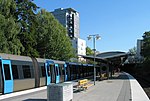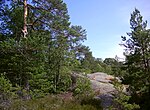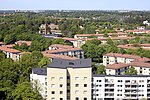Råcksta Träsk
Geography of StockholmLakes of Stockholm CountyNorrström basin

Råcksta Träsk (Swedish: "Råcksta Swamp") is a small lake in the western suburbs of Stockholm, Sweden. Notwithstanding its location in the vicinity of the Swedish capital and high levels of lead and copper, the lake is considered as an important breeding ground for frogs, of moderate interest to pleasure fishing, and of minor interest for birds. There are three other small lakes located nearby: Judarn, Kyrksjön, and Lillsjön.
Excerpt from the Wikipedia article Råcksta Träsk (License: CC BY-SA 3.0, Authors, Images).Råcksta Träsk
Kanaans väg, Stockholm Råcksta (Hässelby-Vällingby stadsdelsområde)
Geographical coordinates (GPS) Address Nearby Places Show on map
Geographical coordinates (GPS)
| Latitude | Longitude |
|---|---|
| N 59.352483333333 ° | E 17.875047222222 ° |
Address
Kanaans väg
168 47 Stockholm, Råcksta (Hässelby-Vällingby stadsdelsområde)
Sweden
Open on Google Maps











